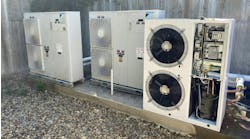The sizing of the snow-melt system’s physical plant and tubing density is dependent upon the system designer’s wishes about its final capabilities. In most cases, decisions about the ASHRAE classification, local weather conditions and the customer’s needs have all been taken into consideration, and a tubing manufacturer’s sizing manual has been consulted.
The tubing manufacturer will typically ask about the ASHRAE category of system (Classes 1, 2 or 3), snowfall temperature and density (actual temperature of the snow), minimum allowable outside air temperature during snow-melt operation, wind speed during snow-melting operation, anticipated snow fall per hour in inches, required melting surface temperature, percentage of glycol in the circulating fluid, depth of tubing below the melting surface and whether insulation will be placed below the snow-melt surface and at its edges.
Once these parameters have been covered, a tubing density schedule is developed and required flow rates and overall Btuh capacity of boiler plant is estimated.
For a typical system operating with a surface temperature of 38°F, an outside air temperature of 0°F and a 10 mphwind, the approximate load per square foot is around 150 Btu. This is a typical rule of thumb used by many people in the industry, and it works well. I would still recommend that you run the numbers yourself and determine what’s best for your area and application.
This means that if the tubing is 58-in. I.D., and it is installed on 9-in. centers, and supplied with 140°F fluid temperatures, it will deliver 150 Btu per square foot per hour with 1-in. per hour of snowfall when the outside temperature is 0°F with a 10 mph wind blowing across the snow-melt surface.
While these conditions are rare, they are the equivalent of design conditions used for sizing space heating systems. The system must be capable of maintaining the prescribed conditions in order for the system to work correctly.
In the retail store job that we performed, the engineer had designed the system to have its tubing spaced 9 in. on center, and an estimated load of 185 Btuh per square foot. The trick of tying tubing 9 in on center has probably been experienced by anyone working with the industry standard welded wire mesh (WWM) that is 6 in. on center. If the slab engineering calls for rebar, you can have the steel workers tie the rebar on 9-in. centers, with the steel running 12 in. on center at a right angle to your intended grid. This makes it a little easier for your tube tyers to stand in between the grid sections while tying the tube to the rebar.
Anyone who has had experience tying tube to WWM will also tell you that only people who are really into pain would use the WWM that comes rolled up. Besides the fact that it wants to roll itself back onto the roll once you unroll it (with you somewhere in the middle), it rarely if ever is conducive to laying out your tubing patterns in a nice and straight fashion.
Do yourself and your company a favor and find the flat steel mesh that comes in 8-ft.-by-20-ft. pieces. It lays down flat, stays down and goes in straight. The problem of tying the tube 9 in. on center, however, still is a problem with the grid set 6 in. on center.
Here’s a trick for you to remember. Order twice as many sheets of flat mesh steel and offset their grid by one half. You end up with what appears to be grids with 3-in. centers, which makes it quite convenient to tie tubes at 9 in. on center. The additional cost of the steel is offset by the labor savings of not having to jury-rig nylon ties together to keep the tube from floating off of the intended 9-in. centers.
The depth of the tubing is also important to the efficient operation of the system. While it is true that concrete has little R-value, it still represents resistance to the upward flow of heat. The closer you can keep the tubing to the top surface (within reason) the better the system will work. Keeping the tube perfectly in alignment to the melting surface is a tough job, but you must make an effort to do this. Otherwise the surface will react slowly to thermal input.
Many devices are available on the cement market for performing this feat. These devices are called “chairs” and are commonly used to keep the reinforcing steel elevated in the slab profile. I have also used some adobe bricks with wire in them to accomplish the same thing. Just make sure that you do something, or the system’s operating characteristics can be affected.
I would strongly recommend that you keep the placement of the insulation within your company’s control. The insulators probably are not aware of the critical need for full and complete coverage of the insulation, and they probably do not have your best interests in mind. Take the time and do it right.
For the same reason, I will not allow the concrete guys to lay my mesh steel, even though their labor factor is probably considerably less than mine. If the steel is not laid out perfectly straight, then it makes it virtually impossible to do a good and professional job of installing the tubing. Remember, you have one shot at doing it right before the mud men come and cover up all your handy craft.
Tune in next month as we look at the driving forces behind a commercial snow-melt system.
Mark Eatherton is a Denver-based hydronics contractor. He can be reached via e-mail at [email protected] or by phone at 303/778-7772.

